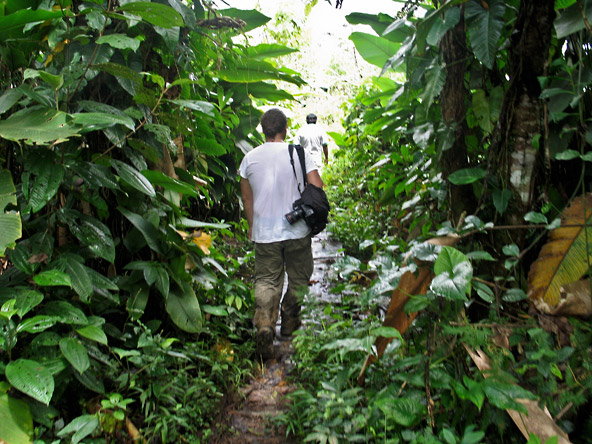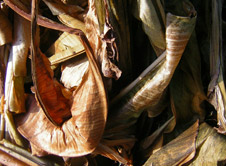
June 2007. Carlos Villalon walks through cloud forest in Narino, Colombia on the way to coca fields.
Photo: Phillip Robertson
We caught a packed buseta from Apartadó to Turbo with thirty other Colombians and watched the banana fields roll by for an hour, all carefully cordoned off by barbed wire. Banana trees with broad flop-eared leaves and their unpicked fruit hermetically sealed in blue plastic, the trees growing a pre-packaged product for the American buyer that comes without blemishes or bruises. Once we hit the end of the line, the driver took us out to the military base where the captain was waiting for us in the sun. "You guys came in that?" "Yes." "That's a weird looking taxi." The captain laughed. Our bus driver turned out to be an informant who told everybody, including the demobilized paramilitaries, that two foreigners just showed up at the guardacostas station. There was no way to hide from it, the whole town knew who we were from the moment we landed.
Captain Garcia took us inside the severely air-conditioned office and introduced us to his men. The captain treated us to an American-style PowerPoint briefing, cataloging the tons of cocaine intercepted every year by his crews. Dozens and dozens of tons according to the slides. A respectable amount but still a fraction of the hundreds of tons of cocaine that make it through. Carlos talked about his time in the jungle photographing the FARC and unnerved the captain with his extensive knowledge of cocaine smuggling. Captain Garcia conceded that there was really no stopping the drugs, and there hasn't been. According to the DEA, The quantity available in the United States has not dropped since the advent of the Plan Colombia, the multibillion dollar eradication program. Colombian production actually went up during a period of intense spraying and military actions, the growers just moved to different parts of the country. Who is behind the trade? Although the FARC is involved deeply in the business, it is the right wing United Self-Defense Forces of Colombia (AUC) that worked closely with the cartels to organize the smuggling system. Coca growers, who are usually poor peasants or campesinos, earn the least of all.
As the cocaine flows down the Atrato river into the gulf of Urabá, it eventually makes its way toward the US and Europe through a network of shifting routes. The drug traffickers send the drugs over land through Mexico and as well as sending it by sea with stops in intermediate countries. At each stage, the value of each pure kilogram increases, and by the time it reaches the United States the street cost has reached as much as $100,000. The more varied the routes, the lower the risk to the trafficker-a system that rewards creativity with millions of dollars. Captain Garcia's job is to intercept these shipments in the gulf of Urabá in an American-made fast boat called Midnight Express. Smugglers also use their own fast boats to move the cocaine, sealing the kilogram bricks inside small custom-built fiberglass hulls. At the destination, they remove the cargo and destroy the boats. On his base, Garcia keeps a haphazard museum of these intercepted lanchas with their hulls ripped open.
The Midnight Express is a steroidal machine, and it has a drug-runner feel to it, even though in its normal configuration the boat is sold as a half-million dollar fishing vessel. It is a mystery why anyone would need a thousand horsepower to go catch sea bass and marlin, but it is great for going fast. Garcia's 30-foot boat has four outboard engines, an excellent radar system with GPS and coastal maps, sonar, and a mount for a .50 caliber machine gun on the deck. The captain raced us out into the gulf where we found a line of banana freighters towing barges on a choppy afternoon sea. The lumbering freighters rose out of the water above us, rust-streaked leviathans.
We drew alongside one of these vessels, the reefer ship Nelson Star, while Garcia called her skipper on his cell phone and said we were going to board with the German shepherd. The captain of the Nelson was not happy about it, although he agreed. Garcia's Midnight Express pilot maneuvered his vessel with skill, but the seas were too rough and we were too low in the water to reach the descending gangway. It reminded me of two species, unable to mate. As the Nelson crew lowered the stairs, they wouldn't reach down to our deck, and the captain called off the attempt.
The crew of the Nelson had gathered by the railing to watch Garcia, all of them wearing the same grease-stained blue coveralls. They did not wave or make any gesture of greeting. If we could have yelled out questions over the water, they could have explained that they were carrying fruit in refrigerated holds like all the other freighters in the gulf of Urabá. A long time member of her crew might have also told us that the Nelson had not always been the Nelson, but had changed her name from the Chiquita Jean when Chiquita Brands sold her back in 2003 to a Norwegian shipping company, along with the rest of its entire fleet. In fact, from the moment of her birth in the Norwegian yards in 1992 until 2003, the ship was a Chiquita freighter, designed to keep the fruit in perfect condition on its long voyage over the oceans. The captain said, "Sometimes they put the drugs on the banana boats." It was a stunner. Before Garcia mentioned it, I was under the impression that drug traffickers only used small fast boats to move cocaine from place to place, but this is not true. The freighters are difficult to search and blend into normal shipping traffic because that is what they are. They can also haul a ton at a time if the kilo bricks are well hidden.
 LEAD IMAGE: Dried banana leaves.
LEAD IMAGE: Dried banana leaves.Photo: Unknown
© Phillip Robertson, 2009-2014.
